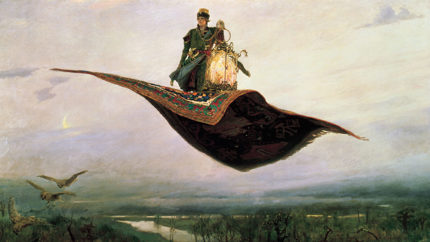The history of the magic carpet is colourful, to say the least.
If you’ve heard of ‘Aladdin’, there’s no doubt you’ve also heard of magic carpets.
But there’s so much more to them – going well beyond Disney’s singular (and very quirky) interpretation.
If you’ve never looked into the topic before, you may be surprised by the extent to which magic carpets have been sensationalised and fabled in the past (a.k.a., pre-Disney) – particularly when it comes to Arabic, French and Slavic folklore.
Stemming from many ancient, storytelling artefacts – including scrolls written by the 13th century Jewish scholar Ben Sherira, and the legendary compendium of tales One Thousand and One Nights – stories about the enchanted object, who it originally belonged to and what its role was, range greatly.
One of the stories dictates that the magic carpet was a love token, gifted to King Solomon by the Queen of Sheba.
Green, gold and elegant beyond belief (looking something like this, we’d wager) it was, according to ancient scholars, tinted with a ‘special’ dye that gave it ‘magnetic’ properties, enabling it to fly as the earth was supposedly magnetic, too. It was, also, a cool sixty miles long – both widthways and lengthways (a.k.a., a total packaging nightmare).
According to the tale, the King was too distracted to receive Queen Sheba’s extravagant gift, so pawned it off on his courtiers – the Queen, on receiving the news, was heartbroken, and the art of making magic carpets forgotten. A real shame.
Alternately, other fables claim that it was God who was the original ‘gifter’.
God, apparently, granted King Solomon with a magic carpet to help him fly from Damascus to Media – an air vessel that allegedly fit 40,000 men (Not even our Large Rugs range can do that!). However, Solomon got a little cocky on receiving his present, frustrating God and inspiring him to shake the carpet as it flew, sending all men – including the arrogant King – into the air. Grisly.
Fantastical as these stories may seem, sometimes the lines between ‘fable’ and ‘fact’ have blurred.
A site owned by a museum in Iran has recently purported to tell the ‘true’ history of the flying carpet, according to the BBC.
Like the fables, it claims that the carpet was invented around the time of King Solomon – but the object, according to the site, wasn’t restricted to his ownership only, and production flourished later with the help of artisan makers in 11th century Baghdad.
The carpets were thought to have had a myriad of uses: military (launching airborne attacks), commercial (transporting goods), and cultural (helping readers in the library at Alexandria reach the high books) – its use ending, ultimately and abruptly, when the Mongols invaded Central Asia.
Yet though King Solomon often takes centre stage when it comes to magic carpet stories and ‘history’, there were a couple of other key carpet riders.
In Slavic folklore, a witch named Baba Yaga gave Ivan the Fool (a simple-minded character that often appears throughout Russian stories), a magic carpet to help him travel through the country at a far greater speed.
There’s also, of course, the original stories on which ‘Aladdin’ itself was based. In One Thousand and One Nights, a dashing prince, Prince Hussain, travels to Bisnagar in India and buys a ‘magic teleporting tapestry’ (a.k.a., a magic carpet), to go on adventures within the ‘blink of an eye’.
According to the tale, the carpet moved by reading its master’s thoughts, travelling to wherever he fancied in his head.
Although the ‘hype’ has somewhat died down, magic carpets still appear in popular culture.
Largely in games, magic carpets feature from time to time in the modern age – appearing in the likes of The Legend of Zelda, RuneScape, World of Warcraft, the film The Thief of Bagdad and even Harry Potter (as illegal vehicles in wizarding Britain).
So are they making a comeback?
Slowly, but surely. Hey – we’ve had vampires and zombies. Why not magical soft furnishings? It could happen.
Any thoughts? Share your ideas and questions with us over at London House Rugs Facebook or Twitter page. We’d love to hear from you!
